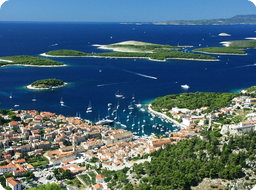

Hvar/island of Hvar
Hvar/island of Hvar  History of Hvar
History of Hvar
Hvar’s history has already lasted millennia. Its wealth and contents are the result of the various circumstances and advantages of Hvar. The maritime position of the port of Hvar was certainly important. From the very beginnings of seafaring, the island of Hvar was situated in the centre of the Adriatic sea routes. The port of Hvar, protected by small islands and having an excellent natural shape, made a safe haven for boats hiding from the perilous winds.
Here are the most important dates in the rich historical adventure of Hvar.
1st millennium BC
The earliest known settlement was founded in the area of today’s town of Hvar. It was established by Illyrians and was spread along the slopes of the hill on the northern side of what is now the town square (which was then a small lagoon that came all the way to where the cathedral is today). There was a fort on the top of the hill.
4th century BC
Greeks from the island of Pharos established PHAROS in what is now Stari Grad.
4th-3rd century BC
Some historians believe that at this time there was a Greek settlement called HERACLEA where Hvar is today.
2nd-5th century
There was a smaller Roman settlement and harbour around the small lagoon, which was later covered and became the town square.
6th-7th century
Hvar (LISINA) was an important naval base in Byzantine Dalmatian. The town itself was located on the site of today’s square. On the southern side of the square, there was a fort.
8th-13th century
Hvar (LESNA) became almost deserted. The Benedictine monastery of St. Mary’s was at the end of the lagoon, where the cathedral stands today.
11th century
Hvar became part of the Croatian state.
1278
Under the powerful influence of Venice, the island’s centre was moved from Stari Grad to Hvar. Hvar became the centre of the diocese (which consisted of Hvar, Brač and Vis) and communal government.
1420
Hvar was once more occupied by Venice and remained under its rule until 1797. As part of the Venetian state, Hvar was the main military and naval base in the Adriatic and an important transport centre. Its development was based on agriculture, fishing, sailing and trade. In this period, Hvar’s recognisable urban character was established and its culture also developed (numerous poets, playwrights, historians and theologians). The first public theatre, founded in 1612, is certainly the most important part of this heritage.
1510, 6th of February
A miracle in Hvar! A small wooden cross bled.
1510-1514
Permanent armed conflict between the nobles and citizens ended in Venice’s intervention.
1571
The island of Hvar was attacked by the Turks.
1579
An explosion of gunpowder in the town fortress caused great destruction in the town of Hvar.
1813-1918
Hvar was a part of Austria. This was a period of economic and cultural decline in Hvar which lasted until the end of the 19th century and the development of viticulture.
1868
A group of leading Hvar residents, led by Bishop Juraj Dubković, founded a professional tourist association by the name of “The Hygienic Association of Hvar”, which aimed to promote and develop tourist services in the town. The association was the forerunner to the Tourist Board of the Town of Hvar.
1900
The Empress Elisabeth convalescence hotel was founded in the grounds of the Doge’s palace. Today it is the Hotel Palace.
1921-1941
Hvar was part of the Kingdom of Yugoslavia. It was a period of poverty and migration overseas. The gradual development of tourism provided new economic opportunities in Hvar. Finance for the development of tourism and promotion of Hvar were secured. The town bathing area was built and was considered the most beautiful in the Adriatic.
1945-1990
Hvar was transformed from a small provincial town into a summer tourist resort, which resulted in mass recreational tourism in the summer.
1991
Hvar became part of its homeland again in a free and independent Republic of Croatia. During the Homeland War, Hvar provided refugees with accommodation.
2003
In the post-war period, Hvar again become an “in” destination for young European tourists. There were over half a million overnight stays despite the world tourism recession.
(M. Petrić)
Source: www.tzhvar.hr
Video
Current news
 Macrocruise charter agency
Additional discount on the boat rental price of betw
Macrocruise charter agency
Additional discount on the boat rental price of betw
































